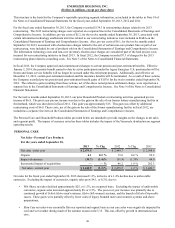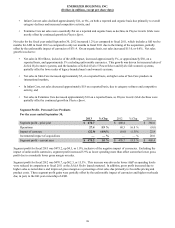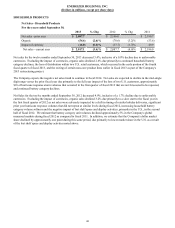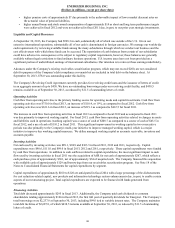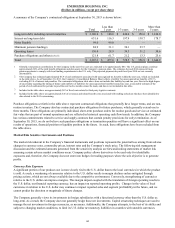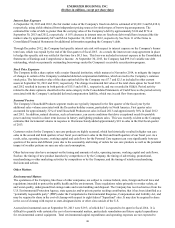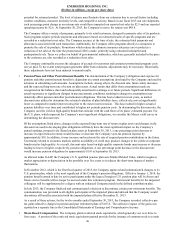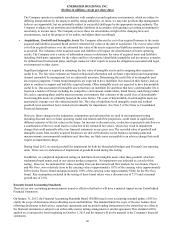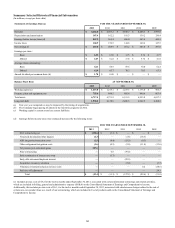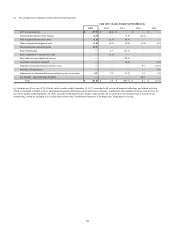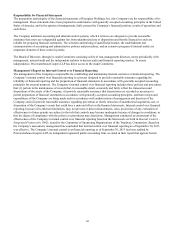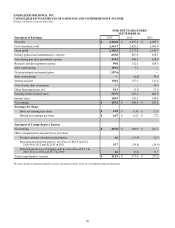Energizer 2013 Annual Report Download - page 58
Download and view the complete annual report
Please find page 58 of the 2013 Energizer annual report below. You can navigate through the pages in the report by either clicking on the pages listed below, or by using the keyword search tool below to find specific information within the annual report.
ENERGIZER HOLDINGS, INC.
(Dollars in millions, except per share data)
potential for returned product. The level of returns may fluctuate from our estimates due to several factors including
weather conditions, customer inventory levels, and competitive activity. Based on our fiscal 2013 sun care shipments,
each percentage point change in our returns rate would have impacted our reported net sales by $2.9 and our reported
operating income by $2.6. At September 30, 2013, the Company's reserve for returns was $49.8.
The Company offers a variety of programs, primarily to its retail customers, designed to promote sales of its products.
Such programs require periodic payments and allowances based on estimated results of specific programs and are
recorded as a reduction to net sales. The Company accrues, at the time of sale, the estimated total payments and
allowances associated with each transaction. Additionally, the Company offers programs directly to consumers to
promote the sale of its products. Promotions which reduce the ultimate consumer sale prices are recorded as a
reduction of net sales at the time the promotional offer is made, generally using estimated redemption and
participation levels. Taxes we collect on behalf of governmental authorities, which are generally included in the price
to the customer, are also recorded as a reduction of net sales.
The Company continually assesses the adequacy of accruals for customer and consumer promotional program costs
not yet paid. To the extent total program payments differ from estimates, adjustments may be necessary. Historically,
these adjustments have not been material to annual results.
• Pension Plans and Other Postretirement Benefits The determination of the Company’s obligation and expense for
pension and other postretirement benefits is dependent on certain assumptions developed by the Company and used by
actuaries in calculating such amounts. Assumptions include, among others, the discount rate, future salary increases
and the expected long-term rate of return on plan assets. Actual results that differ from assumptions made are
recognized on the balance sheet and subsequently amortized to earnings over future periods. Significant differences in
actual experience or significant changes in macroeconomic conditions resulting in changes to assumptions may
materially affect pension and other postretirement obligations. This has been evident in recent years, as market
discount rates utilized to determine the actuarial valuation of plan liabilities have, collectively, moved significantly
lower as compared to market interest rates prior to the most recent recession. This has resulted in higher actuarial
pension liabilities over time and contributed to higher net periodic pension costs. In determining the discount rate, the
Company uses the yield on high-quality bonds that coincide with the cash flows of its plans’ estimated payouts. For
the U.S. plans, which represent the Company’s most significant obligations, we consider the Mercer yield curves in
determining the discount rates.
Of the assumptions listed above, changes in the expected long-term rate of return on plan assets and changes in the
discount rate used in developing plan obligations will likely have the most significant impact on the Company’s
annual earnings, prospectively. Based on plan assets at September 30, 2013, a one percentage point decrease or
increase in expected asset returns would increase or decrease the Company’s pre-tax pension expense by
approximately $10. In addition, it may increase and accelerate the rate of required pension contributions in the future.
Uncertainty related to economic markets and the availability of credit may produce changes in the yields on corporate
bonds rated as high-quality. As a result, discount rates based on high-quality corporate bonds may increase or decrease
leading to lower or higher, respectively, pension obligations. A one percentage point decrease in the discount rate
would increase pension obligations by approximately $110 at September 30, 2013.
As allowed under GAAP, the Company’s U.S. qualified pension plan uses Market Related Value, which recognizes
market appreciation or depreciation in the portfolio over five years so it reduces the short-term impact of market
fluctuations.
In November 2012, which is the first fiscal quarter of 2013, the Company approved and communicated changes to its
U.S. pension plan, which is the most significant of the Company's pension obligations. Effective January 1, 2014, the
pension benefit earned to date by active participants under the legacy Energizer U.S. pension plan will be frozen and
future service benefits will no longer be accrued under this retirement program. Retirement benefits for the impacted
colleagues will be supplemented to a degree with an enhanced Company match in the defined contribution plan.
In July 2013, the Company finalized and communicated a decision to discontinue certain post-retirement benefits. The
communication was provided to all eligible participants of the impacted plans and advised that the Company would
discontinue all benefits associated with the impacted plans effective December 31, 2013.
As a result of these actions, for the twelve months ended September 30, 2013, the Company recorded collective pre-
tax gains related to changes in pension and post retirement plans of $107.6. The collective impact of the gains was
reported on a separate line in the Consolidated Statements of Earnings and Comprehensive Income.
• Share-Based Compensation The Company grants restricted stock equivalents, which generally vest over three to
four years. A portion of the restricted stock equivalents granted provide for the issuance of common stock to certain
48


